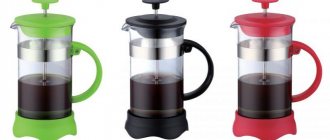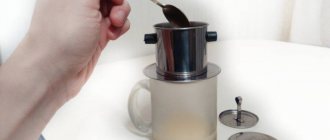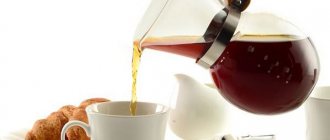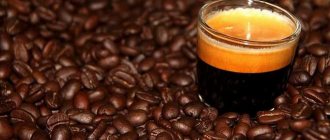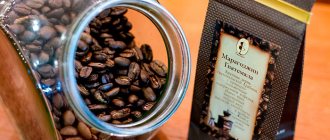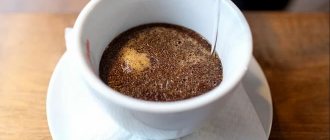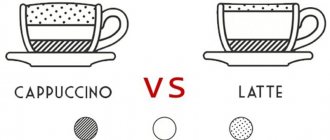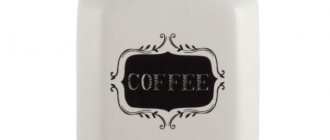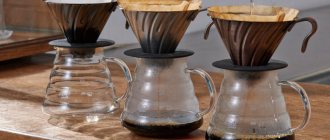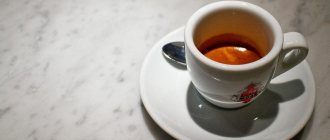Many Russians use the French press as a tea infuser, and few people know that this device was originally developed for making coffee. A French press is an excellent alternative to expensive coffee makers and coffee pots, which require brewing the drink on the stove. But to make the coffee truly aromatic and rich, it is important to know certain nuances of working with the device.
Types of French press, advantages and disadvantages of use
On sale you can find many options for this design. They differ in volume, material of manufacture, configuration and brand of manufacturer. When choosing, it is important to consider the main points of preparing the drink, as well as the environmental friendliness of the material. Thus, it is advisable to give preference to a glass flask, and additional elements should be made of stainless “food” steel.
You may be interested in: Cinnamon Tea
Plastic parts, especially the brewing body, are not allowed. When in contact with hot liquid, and especially concentrated tea leaves, even the most resistant plastics can release substances hazardous to health, and such additives certainly will not be beneficial, especially if used regularly.
Among the main advantages of the French press are:
- Affordable price. Such a device can be purchased as a gift, as well as for personal use, without much damage to the budget.
- Easy to care for. The French press is easy to clean, which housewives will definitely appreciate.
- Excellent brewing quality. Tea brewing fully reveals its taste, and coffee can be made to the desired strength by adjusting the proportions.
- The device does not take up much space and fits perfectly into any interior.
Among the disadvantages is the fragility of the glass flask. It can break if accidentally dropped, as well as with a strong temperature change (for example, when brewing immediately after rinsing in cold water). Many owners note the short period of use of such a teapot, while traditional dishes can last for years. Also, for lovers of automatic devices, “manual control” of a French press may be inconvenient.
To prepare different drinks, it is advisable to have two separate devices in stock. The fact is that brewed coffee has a brighter taste and aroma, so the tea brewed after it will “lose” part of its taste characteristics.
Customer Reviews
Alexandra, Voronezh: “For a work office, a French press is an excellent option. Makes coffee quickly and tasty. I recommend!"
Yana, Arkhangelsk: “Our family likes to drink tea and coffee. We prefer loose, large-leaf tea, and freshly ground and freshly brewed coffee. I saw French press in the store a long time ago, but I didn’t have anything like it at home. And then my husband bought it. The quality of the brewer is good, so I never regretted the purchase.”
Irina, St. Petersburg: “I have two French presses at home: one for tea, the second for coffee. It is better not to brew these two drinks in the same container. Then the smells and tastes won’t mix!”
Origin story
A French press is a glass flask in a glass holder with a lid, to which is attached a sieve on a piston plunger. The design does not have separate compartments for water and grains; the drink is obtained by straining the infusion at the moment the piston is lowered.
This technology was first patented by the Italian Attilio Calimani in 1928. However, the production of such teapots was launched a little earlier - in 1913 in France. Louis Forest launched Cafeolette, teapots with a metal piston filter. The device was intended for only one type of drink - coffee with milk. The ground grains were poured with hot milk, left to steep for several minutes and then filtered using a piston.
But the Italians did not want to give up their championship. In 1958, coffee inventor Faliero Bondanini presented the world with an improved form of French press - a glass flask in a metal frame with a steel plunger mechanism. This model was patented under the name “Chambord”, but it was still produced by the French factory Martin A.
Since that time, designers and aesthetes have changed the material and appearance of the convenient teapot many times, leaving the basic design unchanged - the glass flask and plunger. The flask glass holders were painted in the Gzhel and Khokhloma style, the handle was designed in vintage, hi-tech or fantastic steampunk style. The French press awakened the creativity of craftsmen with the fantastic aroma of coffee.
American Press - the latest word in coffee technology
But brave American innovators attempted to modify the basic design. In 2020, a fashionable coffee device appeared on the market - the American press. Unlike its predecessor, the American version demonstrated significant advantages:
- the flask is no longer made of ordinary glass (the fragility of which has always been a disadvantage of the French press), but of two-layer polycarbonate. This material is just as transparent, but has super strength; it is used to make windows on airplanes;
- there is no cup holder with a holder, but they are not needed - the thermal conductivity of polycarbonate is low, it is impossible to burn your hands on the walls of the teapot;
- a sealed compartment for ground beans with the finest metal filters of 100 microns appeared;
- a smooth plunger allows you to vary the lowering speed, due to this you can control the degree of brewing;
- The hydraulic seal separates the hot water and the brewed drink, resulting in the most efficient coffee extraction.
Interesting: extraction is a term from a chemistry course; it has entered the professional lexicon of baristas and means the process of extracting beneficial ingredients from ground coffee. This is the highest skill: choosing the right proportions of water and coffee beans to get a drink with a delicate aroma and bright taste.
The walls of the French press flask do not maintain the temperature of the drink for a long time, so it is recommended to brew coffee immediately before a meal. There is no need to leave the meal (coffee grounds) in the brewer; refilling it will be tasteless. The American Press, due to its tightness and two-layer casing, leaves the drink hot for 15-20 minutes.
There is one more difference between the French press and the American teapot. In the classic version, the flask has a spout for pouring the drink into a mug, and in an alternative version, such a spout has been moved to the lid. And yet, the process of preparing a coffee drink for both devices has the same principles.
French press care
Proper care of your French press is extremely important, as the stagnant smell of coffee can ruin the taste of any drink.
French press care is as follows:
- Thoroughly wash the device after each use;
- washing the filter and mesh on all sides, especially where grains accumulate;
- periodic washing of filter parts.
REFERENCE! You can unscrew the filter from the plunger by turning it counterclockwise.
Thus, known to everyone as a tea infuser, the French press is a convenient device for brewing aromatic and rich coffee without the use of a stove and expensive coffee makers. The unique taste of your favorite drink will be ensured by the availability of clean water and freshly ground coarse coffee. We must also not forget about timely cleaning of the device to prevent a musty smell.
Cold Brew, or how to brew cold coffee in a French press
An excellent option for summer, toning and cooling. But due to the fact that not hot water is used, but cold water, the brewing process takes much longer.
- Grind the coffee and pour it into the brewer, maintaining a proportion of 1 tablespoon per 200 ml of liquid.
- Fill with cold water.
- Stir until no dry particles remain.
- You don't have to cover it with a lid.
- Place in the refrigerator for 12 hours. At room temperature, brewing will be faster, 9-10 hours is enough.
- Then insert the filter and squeeze out the grounds.
Important: the drink will be much more bitter and concentrated; it is recommended to drink it with milk or cream, and also add 2-3 ice cubes to the glass.
If you refrigerate coffee brewed in a French press using the standard method, either pour it into a pitcher to drink black or leave it there, but it will still be very bitter and very strong as the oils will liquefy even more under the influence of the temperature .
Advantages and disadvantages
The French press, like any device, has advantages and disadvantages.
| Advantages | Flaws |
| Affordable price | The drink has to be prepared manually |
| The taste of the drink prepared in a teapot is much softer than coffee brewed in a Turk. | To use the coffee maker, you need to boil water. |
| The metal filter reliably protects against unpleasant sediment getting into the cup | You cannot store a finished drink in a French press container. |
| The device allows you to independently determine the time for brewing coffee or tea. This way you can adjust the strength and color of the drink | The flask is made of glass or plastic. Can easily break if handled carelessly |
Secrets, life hacks and useful tips
Perhaps these recommendations will tell you how to brew coffee in a French press even better:
- You can add spices, both ground and whole. But if you use the cold method, remember that they will also be extracted all the time, causing the flavor of the spices to be very intense, even too intense.
- It is often recommended to use a wooden spoon for stirring, as the metal supposedly oxidizes in boiling water. But in fact, there is no difference, except that you can break a glass flask with a large metal spoon.
- Rinse the press immediately after use: coffee oils become clogged in the mesh, dry out, and give the drink a musty smell.
- You should not grind nuts, seasonings and other products in a coffee grinder, as microparticles will remain and be mixed into the grain.
- In general, it is recommended to brew Indonesian coffee (Java, Sumatra, Bali and other regions) not for 4 minutes (1 for steaming and 3 waiting), but for 6 minutes, so the taste will develop better.
Experiment with grinding, steeping time and other parameters, and as a result you will learn how to prepare the perfect drink according to your preferences. Any standards are not a dogma, but only a guide.
What determines the taste of the drink?
It would seem – add coffee, add water, lower the filter – what’s so complicated about that? But there are nuances that affect the taste of the finished drink.
Water
Too hard or too soft, oversaturated with minerals, it can significantly change the taste. It is advisable to use filtered or bottled water (read the composition carefully, some bottles contain water with the addition of beneficial minerals, not yet medicinal, but with a changed taste).
Water temperature
Scalding grains with boiling water is a bad idea, but underheating is also dangerous. On websites that tell you how to brew coffee in a French press, they write about 92–95 degrees, but few people have a special thermometer in their kitchen. It’s easier to navigate this way: boil the water, turn it off and let it sit for 30-40 seconds. If the kettle has already boiled, you don’t have to boil it again, but bring it to a boil: when the noise becomes quieter, you can turn it off and use it immediately.
Grinding
Rough and even is best. This is provided by home manual coffee grinders and professional millstones. Many people have a knife coffee grinder in their kitchen - a compact device roughly comparable in size to a French press - but this is not the best option because the grains are crushed unevenly and there are fine dust, medium and large particles. The extraction will be uneven, and a fine suspension will also end up in the cup, making the drink cloudy. As a last resort, you can experiment with already ground coffee from different manufacturers.
Grind freshness
The best beans should be ground immediately before preparation: remember how a sliced apple oxidizes and darkens in half an hour - so, the same thing happens with coffee, only not so obviously.
If it is a mass product, store-bought coffee sold by weight, the freshness of the grind is not so important, but for elite beans it is still better to buy a good coffee grinder for home. For a manual coffee grinder, it is important to be able to set the coarse grind by turning the pressure screw.
Quantity of coffee
There is often an opinion that French press coffee turns out weak and watery. There are simply not the same ratios of grains and liquid as for other methods. Although there is no strict standard, the best baristas have ratios from 1:10 to 1:18, so you can focus on something in between. Light roast coffee weighs a little more because it loses less moisture during the roasting process. Therefore, you can put it a little more than fried until dark. If the roast is intense, try adding a little less.
Try adding 1.5 heaping tablespoons of ground coffee to 200 ml of water, then adjust the amount to taste. Perhaps more will be needed.
What types of drinks can be made in a coffee press?
The classics are preparing Americano, espresso and spiced coffee in a French press. The device can also be used to froth milk for cappuccino, but it is not recommended to brew coffee with milk.
Please note: Only cardamom, nutmeg, ginger or cinnamon are added to the flask. Nothing but spices are added to it during brewing.
You can also make cappuccino in a French press:
- Brew the coffee as you would a regular Americano for 4 minutes;
- Beat the foam;
- Combine them in a cup
How to whip cappuccino foam using a French press:
- Heat the milk;
- Pour it into the flask;
- Move the piston back and forth vigorously for half a minute;
- If the foam does not rise, continue;
- Immediately pour milk foam into coffee
What to look for when buying a French press
Despite the simplicity of the design, it is important to pay attention to some nuances when purchasing. This will help you purchase a quality device.
How to choose the right French press:
- The cost of the device cannot be too low. In this case, there may be a manufacturing defect or the use of unsuitable materials in manufacturing.
- The flask should be free of scratches, cracks and foreign inclusions. It is advisable to purchase a French press marked “made of tempered glass”; such material will last longer.
- Determine the appropriate volume. For one serving of drink, 150-200 ml of water is enough, but such miniature teapots are usually not found on sale. They are usually sold in sizes of 350 ml or more, and liter French presses have the largest capacity.
- Build quality. Particular attention should be paid to the tight fit and ease of use of the filter mesh. All elements must be tightly fitted to each other, not interfere with the movement of the piston and not get stuck.
You may be interested in: Ginger and Lemon Tea for Colds
Preference should be given to trusted brands, whose products are often guaranteed. When purchasing, you should also inquire about the possibility of ordering a spare flask, because this element is the most vulnerable in the entire structure.
Which design is the most comfortable?
While teapots are usually round, French presses are cylindrical. In such flasks, the filter is completely adjacent to the walls, preventing tea leaves from leaking into the liquid. The devices look laconic and stylish, in full compliance with the requirements of modern interior concepts. They are good as an office option. Traditional teapots in shape and decor are more suitable for the homeliness of a classic-style kitchen.
But if you plan to purchase a teapot, then you need to take into account the main characteristics and recommendations of experts.
Volume
For home tea drinking, it is better to buy models with large-volume flasks - 700-1000 milliliters. This amount of liquid is enough to prepare a drink for several people at a time.
On a note! You can brew tea again in a press only after cleaning the filter and flask from the tea leaves and washing thoroughly.
Small volume devices are more suitable for making coffee.
Piston and screen materials
The classic version is a strong and durable all-metal piston. It is superior to models with plastic parts not only in reliability, but also in terms of neutrality (silicone rings distort the taste of tea).
The piston connects the filter mesh and the device cover. It is set in motion by pressing the hand. A little effort is required. The piston should move smoothly, without distortions or jams.
The filter consists of three layers:
- frame;
- top plate with holes;
- mesh
The latter is made from different materials:
- polymer (nylon);
- stainless steel.
For those who like to brew small-leaf teas, presses with a polymer filter are recommended. Stainless steel is suitable for brewing large leaves, as well as “broken” (broken tea). It is convenient to prepare coarsely ground coffee in such devices.
Frame
The materials used for French presses are very different - plastic, metal, wood. The flask is fixed using special elements (bottom and top) or inserted into the structure according to the principle of a cup holder.
Primary requirements:
- reliability;
- safety (tight fit of all parts);
- hermetically sealed lid.
Metal handles get hot, so models with plastic linings are preferable.
How to choose a coffee press
There are no special features other than the material for the lid and the height of the French press flask. A coffee press is selected according to the following criteria:
- Material for the flask. The heat-resistant glass of the press will last longer and is protected from cracks, chips, and other mechanical damage;
- Pens. It is better if they are plastic or rubber coated. This will help avoid heating and make brewing convenient;
- Piston quality. The metal should not have burrs or irregularities, the mechanism should fit tightly to the walls of the flask.
A loose French press piston is not always visible to the eye; when purchasing, you can ask to pour water into the flask, and then the defects will become visible when moving.
Do presses vary in price? Yes, kettles from branded kitchen utensil manufacturers can cost as much as a good coffee maker, but nothing distinguishes them except the brand name. The price of about 9,490 rubles per kettle does not make it much better than what is sold for 190 rubles in online stores. The most common presses are 350 ml, allowing you to make two standard cups of Americano or one large one.
Story
The origins of the French press are controversial. Various similar devices began to be invented back in the middle of the 19th century, but the device began to become popular only after the Second World War. The Italians made a huge contribution to the development and design, but the French contributed more to the spread, hence the name of the press.
Now it is a flask made of heat-resistant glass framed by a frame made of metal, plastic or ceramics. The flask is closed with a lid in which a piston is installed, which is a metal rod with a mesh filter at one end and a handle at the other.
This is a classic type of French press, which serves as the concept for many modern innovative devices built on its principle, such as American Press, AeroPress, Espro Press, Rite Press, etc. This suggests that this brewing method is very popular among coffee lovers and will remain so for a long time yet.
